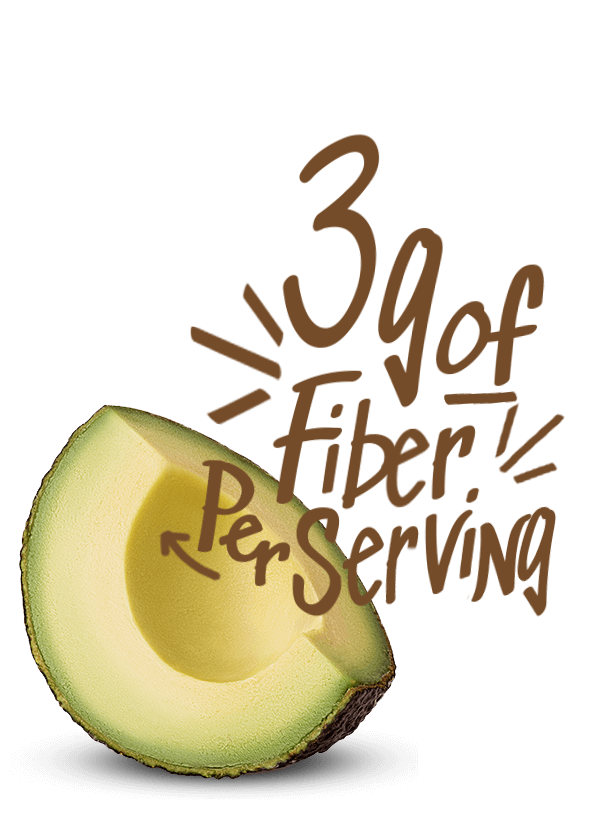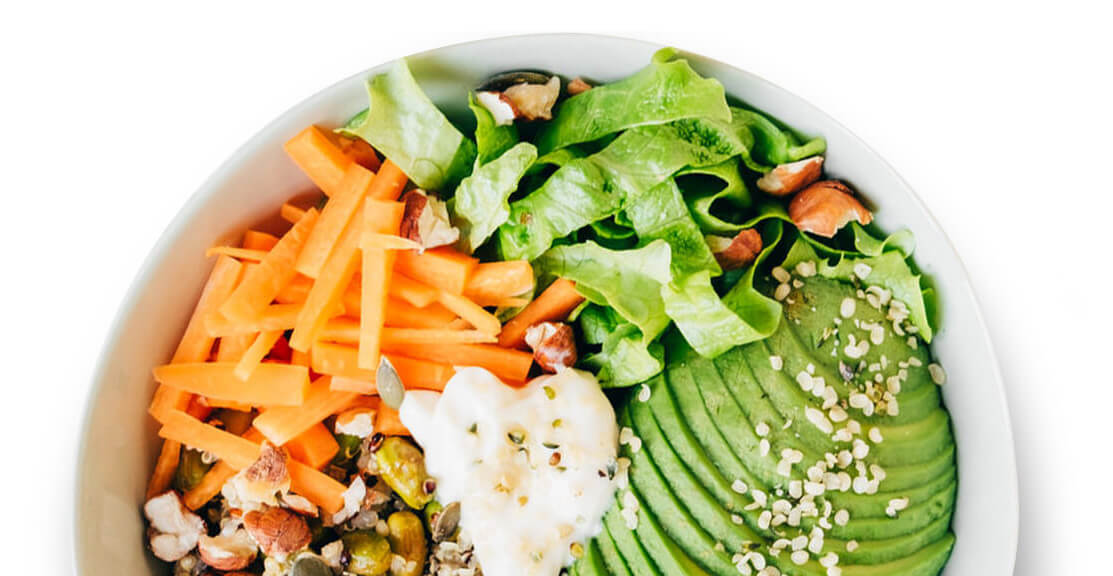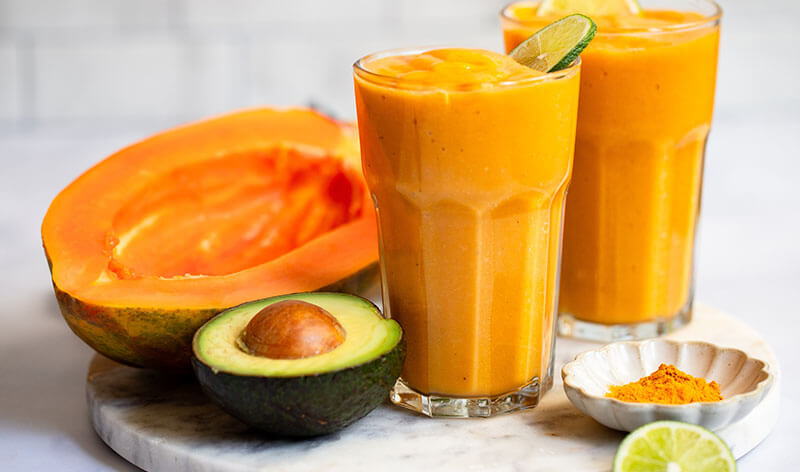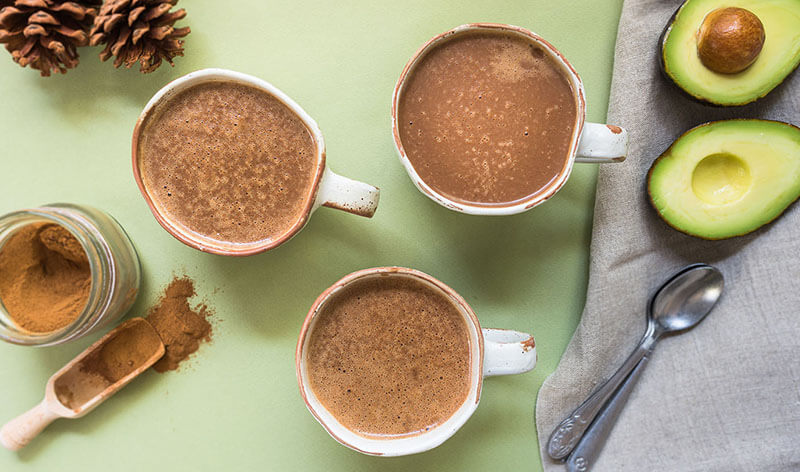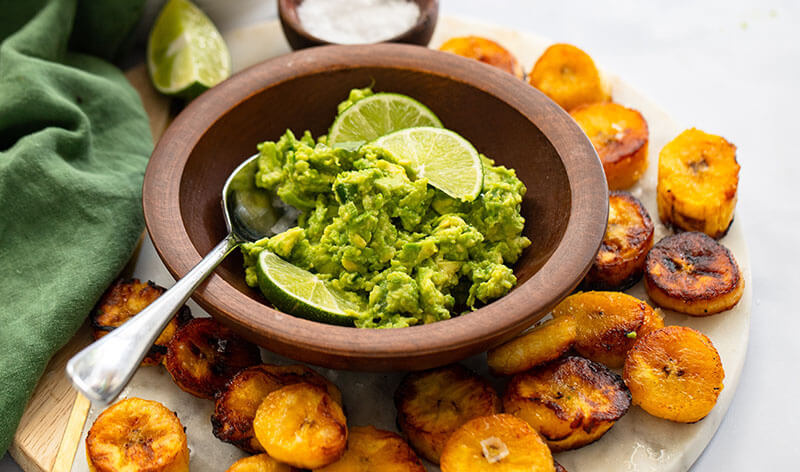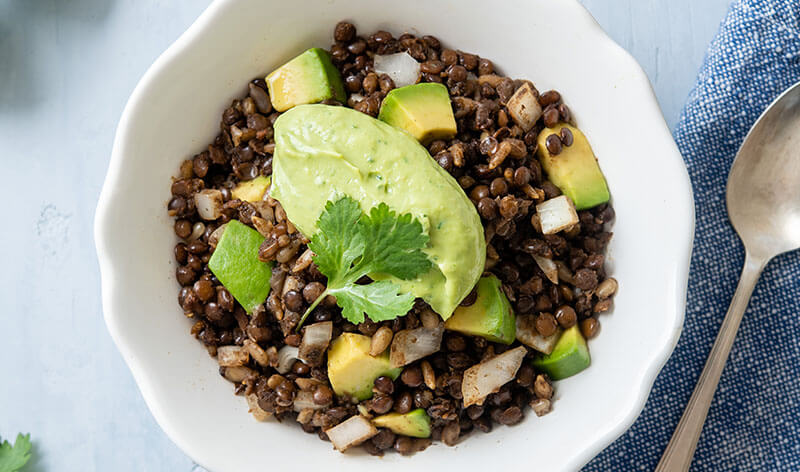Avocados are a good source of fiber, which may help support digestion, weight management, and heart health.
- One serving (1/3 of a medium avocado, about 50 g) provides 3 g of fiber—11% of the Daily Value.
- A whole medium avocado contains 10 g of fiber, making it a great choice to help increase fiber intake.
Fiber in avocados includes:
- Soluble fiber (1 g per serving): May help regulate blood sugar and support healthy cholesterol levels when part of a diet low in saturated fat and cholesterol.
- Insoluble fiber (2 g per serving): Supports digestive health and promotes regular bowel movements.
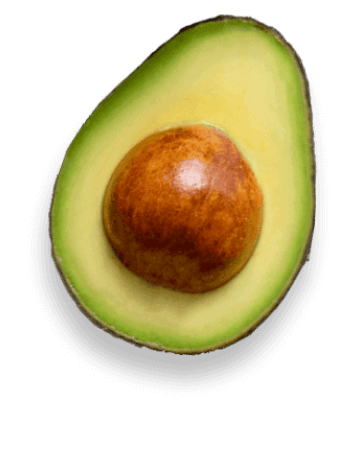
Potential benefits of fiber in avocados:
- May help promote feelings of fullness, supporting weight loss goals.
- Supports gut health by nourishing beneficial bacteria.
Quick tips for adding avocado to your diet:
- Mash avocado on whole grain toast, mix into salads, or blend into smoothies.
- Pair with fiber-rich foods like fruits, vegetables, legumes, and whole grains.
- Increase fiber gradually and drink plenty of water to support digestion.
Likely, you’re not eating enough dietary fiber, and you’re not alone. According to a 2021 publication from the American Society for Nutrition, only 5% of men and 9% of women eat the recommended amount of fiber — 25 g every day, based upon a 2,000-calorie diet. By not eating enough fiber, however, you’re not reaping the many benefits of fiber. But why does it matter?
Dietary fiber is a type of carbohydrate and is an important part of every diet. When looking at a food package, you will see dietary fiber listed on the nutrition facts label. You may also see it listed as soluble fiber or insoluble fiber. Both types of dietary fiber have important health benefits — both regarding weight management and your long-term health. In this guide, we’ll explore these benefits and how to include more fiber in your diet by eating more foods like avocados.
What Is Fiber?
Carbohydrates are one of the three macronutrients (alongside fats and proteins) that the body needs for energy. When consumed, carbohydrates are primarily broken down into glucose, which serves as an energy source for the body’s cells, particularly for the brain and muscles. Carbohydrates are composed of sugar molecules, which can be classified into two categories: simple and complex. Simple carbs are carbohydrates in their most basic form (glucose and fructose), which you can naturally find in fruits and dairy, as well as in processed foods, desserts, and other sugary treats. Your body breaks down these carbs faster. As a result, simple carbs will enter your bloodstream faster than complex carbs. Complex carbs, which you can find in starches and fiber, consist of multiple sugar molecules tied together. Because of their structure, they take your body longer to break down and digest.
While fiber is considered a complex carb along with starches, they differ in that fiber cannot be fully digested or absorbed by the body. Instead, it stays intact as it passes through your digestive system. Because it stays intact, fiber is not broken down into glucose like other carbohydrates. As a result, fiber may help stabilize blood sugar levels by slowing digestion and glucose absorption.
![]()
Soluble vs. Insoluble Fiber
While fiber, in general, can be good for your health, the benefits you may experience depend on your overall health and the type of fiber you consume. Fiber is categorized into two types: soluble fiber and insoluble fiber. Avocados provide approximately 3 g of dietary fiber per serving, a third of which is soluble.
Soluble fiber, found in foods like avocados, grains, seeds, legumes, and vegetables, dissolves in water to form a gel-like substance in your intestines. This slows digestion, which can help manage diarrhea by firming loose stools and promoting a more gradual absorption of nutrients.
Insoluble fiber, on the other hand, doesn’t dissolve in water. Instead, it binds to the water in your stool, increasing its bulk and helping to relieve constipation. This type of fiber supports regular bowel movements and can be found in foods like avocados, whole grains, beans, and root vegetables like beets.
Soluble and insoluble fibers provide unique health benefits due to their distinct effects in the body. Soluble fiber slows digestion and binds to cholesterol in the digestive system, reducing its absorption and lowering LDL cholesterol levels. This can help decrease the risk of heart disease and support better blood sugar control. Insoluble fiber, on the other hand, promotes regular bowel movements by adding bulk to stool, which may contribute to a lower risk of constipation and colorectal cancer. Together, these fibers play a vital role in overall health.
The Benefits of Fiber
Fiber is more than just a digestive aid—it plays a vital role in supporting heart health, weight management, blood sugar control, and gut health. From helping lower your cholesterol and reducing inflammation to keeping you full longer and feeding beneficial gut bacteria, fiber offers a range of health benefits backed by science.
Heart Health
There are plenty of ways that fiber can contribute to your heart health. Dietary fiber from fruit, as part of an overall healthy diet, helps reduce blood cholesterol levels and may lower the risk of heart disease. Avocados are a good source of fiber and are a great way to add variety to the diet.
Consuming foods rich in fiber may reduce the risk of heart disease. Fiber can contribute to lower LDL cholesterol levels, helping your cardiovascular system to operate as normal. The fiber in avocados, as well as the rest of its nutritional makeup, can contribute to a healthy heart. A meta-analysis evaluated the impact of avocado intake on LDL cholesterol. Researchers concluded with moderate evidence that avocado intake has a medium to large effect on LDL-C levels. This study relies on published work, presenting unique limitations, and the findings cannot be generalized to all populations. The researchers assessed the risk of bias and strength of evidence for each of the 12 clinical trials and 14 comparisons. The results from this large study support avocados as a heart-healthy fruit.
Weight Loss
Fiber slows the speed of digestion, which makes you feel full and may help you eat less and stay satisfied longer. This is known as satiety. When you feel satiated, you will feel less inclined to turn to more food soon after eating.
A study of 31 adults with overweight or obesity showed that adding half or a whole avocado to breakfast reduced hunger, enhanced meal satisfaction, and raised levels of PYY and GLP-1 satiety hormones. The Avocado Nutrition Center sponsored the research, which used a visual analog scale to measure subjective outcomes for up to six hours. While further research is necessary for broader applicability, these findings contribute to the growing evidence linking avocado consumption to weight management benefits.
Fiber contributes to a healthy body by helping prevent you from overeating and encouraging normal digestion. While losing weight, be mindful of your fiber intake, and try to get it from whole foods rather than supplements for optimal benefits.
Manage Diabetes Symptoms
Type 2 Diabetes is a chronic condition that occurs when your body’s cells become resistant to insulin, a hormone that helps transfer glucose from your bloodstream into your cells for energy. In response, your pancreas produces more insulin to try to keep blood sugar levels under control. Over time, this increased demand on the pancreas can reduce its ability to produce enough insulin, leading to elevated blood sugar levels. Without proper management, Type 2 Diabetes can result in long-term health complications, such as cardiovascular disease, kidney damage, and nerve damage.
Fiber, particularly soluble fiber, helps regulate blood sugar levels by slowing digestion and delaying the absorption of carbohydrates. This prevents rapid blood sugar spikes after meals, making it easier to maintain stable glucose levels throughout the day. Over time, this can improve insulin sensitivity and reduce the strain on the pancreas. Additionally, by promoting feelings of fullness and reducing hunger and cravings for sugary snacks, soluble fiber can support weight management—a key strategy for managing and even preventing Type 2 Diabetes.
Supports Your Gut Health
Fiber plays a crucial role in supporting gut health, with insoluble fiber and soluble fiber offering distinct benefits.
Insoluble fiber adds bulk to stool and helps food move through the digestive system more efficiently, reducing the likelihood of constipation, which can be uncomfortable and even lead to other complications like hemorrhoids. Regular bowel movements also help maintain a healthy gut environment by minimizing the time potential toxins are in contact with the intestinal lining.
Soluble fiber, on the other hand, feeds beneficial gut bacteria in the large intestine. As these bacteria ferment soluble fiber, they produce short-chain fatty acids (SCFAs), such as butyrate, which support the health of the intestinal lining, reduce inflammation, and strengthen the gut barrier. A balanced gut microbiome, promoted by soluble fiber, is also linked to better digestion, immunity, and even mood.
While slowing the absorption of nutrients like carbohydrates and fats, soluble fiber can also help regulate blood sugar levels and provide sustained energy throughout the day. Together, these benefits make fiber essential for overall gut and metabolic health.
Boost Your Fiber Intake With Avocados
Did you know that most Americans do not eat enough dietary fiber? Avocados to the rescue. They add fiber to the diet and are delicious.
While many foods are a great source of fiber, not many have both insoluble and soluble fiber. Avocados are unique in that they have both. The 3 g of fiber per 50 g serving of avocado comprise one gram of soluble and 2 g of insoluble fiber, so you reap both benefits.
They also provide nutrients like unsaturated fats that can help manage your LDL cholesterol levels and help your body absorb fat-soluble vitamins. In a clinical trial, researchers studied blood cholesterol by monitoring how the addition of one fresh avocado per day, as part of a moderate-fat diet, affected the cholesterol levels of 45 overweight and obese adults. The Avocado Nutrition Center supported this study. While the conclusions come from a single study that cannot be generalized to all populations, the study provides further insights on how avocados affect cardiovascular-disease risk factors, such as LDL, in overweight and obese adults.
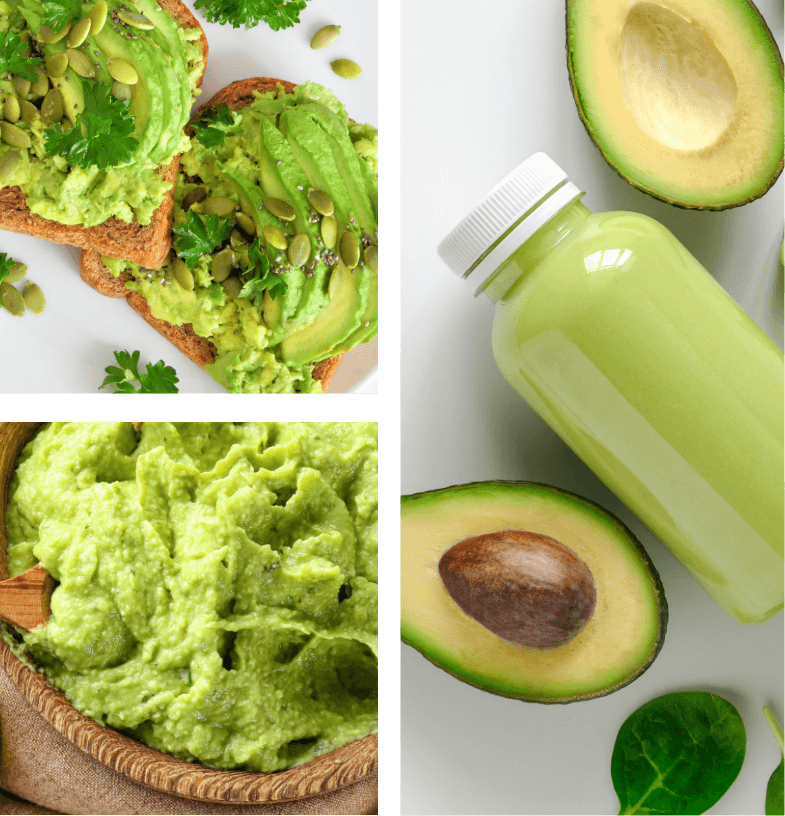

Avocados are also easy to prepare. Whether you’re spreading avocados on some toast, mashing it for guacamole, or blending it in a smoothie, you can enjoy the health benefits of avocados in various ways.

